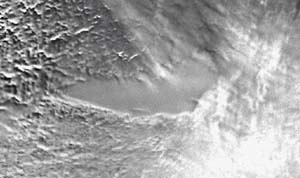
The largest subglacial lake in the world, Antarctica’s Lake Vostok lies beneath 4km of ice, making it spectacularly inaccessible. Using seismic waves and satellite imagery, researchers have mapped the lake’s extent (at 16 square km, and maxing out at one thousand meters deep, it’s roughly the size of Lake Ontario) and have a solid understanding of the lake’s interactions with the glacial ice slowly gliding over it. They also know its age: it has been trapped beneath the Antarctic ice cap for 14 million years. But of the environment of the lake itself and what life it might harbor, they have no direct evidence at all.
That will change, however, when a Russian drilling team reaches Lake Vostok later this month, according to New Scientist. They’ve reached a depth of 3650 meters, placing the drilling head about 100 meters from the surface of the lake. They’re proceeding most carefully now, however; to prevent contamination of the lake’s water with surface microorganisms, the team will let the pressurized lake water flood into the borehole and refreeze. Vostok’s enigma will subsist a little while longer�the Russians won’t take core samples of the frozen lake water until next year.
Vostok is one of some 150 subglacial lakes in Antarctica, and the largest by far. Its isolation is radical: at its edges, the sliding ice creates a hydrostatic seal with the surface crust, preventing water from escaping. The lake exchanges water with the glacier incredibly slowly, replacing its volume every 13,000 years or so (the Great Lakes of North America replace their volumes on the order of tens of years). But conditions in the lake have likely remained essentially unchanged over 14 million years; any life that exists there is liable to exhibit unique adaptations to the extreme conditions of low temperature and high pressure.
More thoroughgoing exploration may lie in the future, if technologists can solve the formidable challenges of operating beneath kilometers of ice. A British team plans to develop a probe to explore the smaller Lake Ellsworth in 2012 or 2013. In the 1990s, NASA’s Jet Propulsion Laboratory began developing a missile-like “cryobot” capable of melting its way to deep lakes and releasing an autonomous vehicle to search for geothermal features and signs of life; that program, however, seems to have stalled. Subglacial lakes like Vostok tantalize astrobiologists, who see them as a testbed for research into the ocean that may lie beneath surface ice on Jupiter’s moon, Europa. But they also promise to help reveal the extent of life on Earth, which has proven its tenacity in the most extreme environments.
 Gearfuse Technology, Science, Culture & More
Gearfuse Technology, Science, Culture & More



This makes me a little sad. Can’t we leave one stone unturned?
16 sq. km? Must be a typo. If it’s the size of Lake Ontario, that’s 19,529 km�. Wikipedia says, “Lake Vostok covers an area of 15,690 square kilometres”
Good catch, tedcheese! Will update the post.